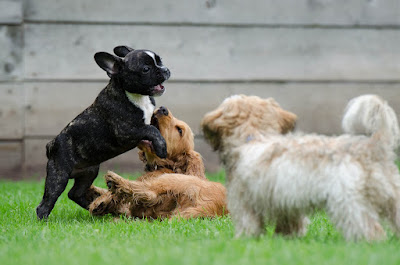Dog Flu - Canine Influenza Symptoms
Canine influenza (dog flu) is influenza occurring in canine animals. Canine influenza is caused by varieties of influenzavirus A, such as equine influenza virus H3N8, which in 2004 was discovered to cause disease in dogs. Because of the lack of previous exposure to this virus, dogs have no natural immunity to it. Therefore, the disease is rapidly transmitted between individual dogs. Canine influenza may be endemic in some regional dog populations of the United States. It is a disease with a high morbidity (incidence of symptoms) but a low incidence of death.
Your dog is coughing and congested, listless and feeling lousy – just like we feel when we come down with a respiratory ailment. |
| Dog Flu - Canine Influenza Symptoms |
The virus is passed from animal to animal through “respiratory secretions, dogs can spread the virus through simply “barking, coughing and sneezing, contaminated objects, such as water bowls, toys, food, clothing, shoes and leashes can also harbor the virus and cause transmission.”
This makes areas where pets congregate, such as doggy day cares, kennels and dog parks, hot spots for disease transmission.
But just because your pet has been exposed to a strain of the virus doesn't mean he will show symptoms. Eighty percent of dogs exposed to the virus will develop signs of the disease within one to five days, while the remaining 20 percent will show no symptoms whatsoever. If your dog went to the park a week ago and seems as spry as ever, you’re probably in the clear.
However, like with the human flu, a dog who is not symptomatic can still pass the virus to other animals. Humans who have been in contact with an infected animal can also unknowingly spread the virus, as it can live on surfaces for up to 48 hours, on clothing for 24 hours, and 12 hours on hands, the AVMA explains. If your dog gets the sniffles, take precautions to wash your clothes with warm water and disinfect your hands and any surfaces, to keep the outbreak in check.
Before you’re tempted to cancel all puppy playdates for the foreseeable future, dog flu has a very low mortality rate of less than 10 percent, and most pups will only contract a mild version.
Symptoms
In its mild form, canine influenza can resemble a kennel cough-type syndrome, where dogs could come down with a soft cough that can last up to a month. Your pup may also seem lethargic or down, and have increased eye and nasal discharge and sneezing.
In a more severe form, dogs can have a high fever, develop pneumonia and have trouble breathing, which may cause them to become dependent on supplemental oxygen.
Cats suffer from similar upper respiratory disease symptoms, such as nasal discharge, congestion and lethargy. See the Video https://www.youtube.com/watch?v=UXzMn9-GxaI
Diagnosis and treatment
If you suspect your dog or cat may have come down with the flu, contact the family veterinarian for guidance. Avoid rushing your pup to the vet’s office, as this could infect other dogs in the waiting room, and your veterinarian may want to take special precautions when meeting you. Your vet can confirm the virus by running a series of tests. “Usually there is a specific test that looks for the virus itself in the animal’s respiratory secretions, such as nasal swabs — that’s how there’s a confirmed diagnosis.
